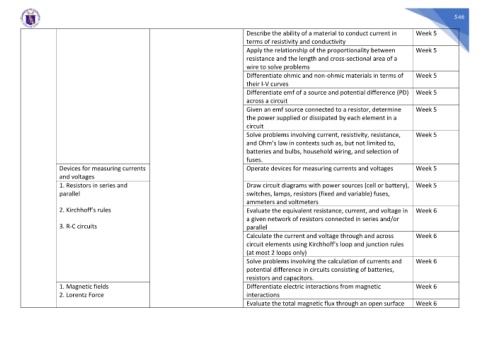Page 546 - Most-Essential-Learning-Competencies-Matrix-LATEST-EDITION-FROM-BCD
P. 546
546
Describe the ability of a material to conduct current in Week 5
terms of resistivity and conductivity
Apply the relationship of the proportionality between Week 5
resistance and the length and cross-sectional area of a
wire to solve problems
Differentiate ohmic and non-ohmic materials in terms of Week 5
their I-V curves
Differentiate emf of a source and potential difference (PD) Week 5
across a circuit
Given an emf source connected to a resistor, determine Week 5
the power supplied or dissipated by each element in a
circuit
Solve problems involving current, resistivity, resistance, Week 5
and Ohm’s law in contexts such as, but not limited to,
batteries and bulbs, household wiring, and selection of
fuses.
Devices for measuring currents Operate devices for measuring currents and voltages Week 5
and voltages
1. Resistors in series and Draw circuit diagrams with power sources (cell or battery), Week 5
parallel switches, lamps, resistors (fixed and variable) fuses,
ammeters and voltmeters
2. Kirchhoff’s rules Evaluate the equivalent resistance, current, and voltage in Week 6
a given network of resistors connected in series and/or
3. R-C circuits parallel
Calculate the current and voltage through and across Week 6
circuit elements using Kirchhoff’s loop and junction rules
(at most 2 loops only)
Solve problems involving the calculation of currents and Week 6
potential difference in circuits consisting of batteries,
resistors and capacitors.
1. Magnetic fields Differentiate electric interactions from magnetic Week 6
2. Lorentz Force interactions
Evaluate the total magnetic flux through an open surface Week 6

